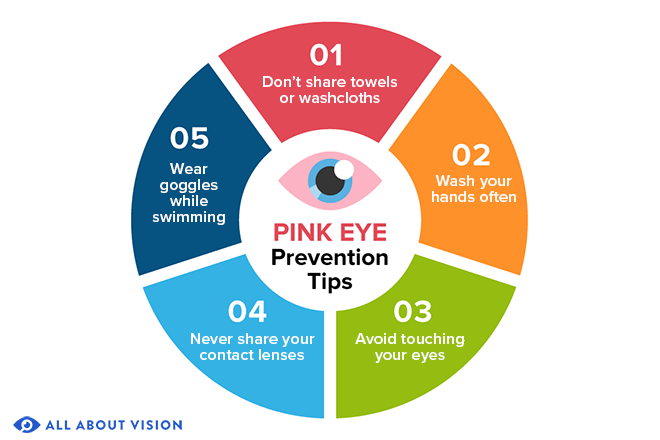DEFINITION OF CONJUCTIVITIS

Pink eye is an inflammation of the transparent membrane that lines the eyelid and eyeball. This membrane is called the conjunctiva. When small blood vessels in the conjunctiva become swollen and irritated, they’re more visible. This is what causes the whites of the eyes to appear reddish or pink. Pink eye also is called conjunctivitis. It’s caused by allergens, irritants, bacteria and viruses, such as coronaviruses that cause the common cold or COVID-19.
Though pink eye can be irritating, it rarely affects your vision. Treatments can help ease the discomfort of pink eye. Because pink eye can be contagious, getting an early diagnosis and taking certain precautions can help limit its spread.
WHAT ARE THE SYMPTOMS OF CONJUNCTVITIS?
Symptoms of pink eye include:

- Redness in the white of your eye or inner eyelid.
- Increased tearing.
- Thick yellow discharge that crusts over your eyelashes, especially after sleep.
- Green or white discharge from your eye.
- Gritty feeling in one or both eyes.
- Itchy eyes (especially in pink eye caused by allergies).
- Burning eyes (especially in pink eye caused by chemicals and irritants).
- Blurred vision.
- Increased sensitivity to light.
- Swollen eyelids.
WHAT ARE THE CAUSES?
Causes of pink eye include:
- Viruses.
- Bacteria.
- Allergies.
- A chemical splash in the eye.
- A foreign object in the eye.
- In newborns, a blocked tear duct.
Viral and bacterial conjunctivitis
Most cases of pink eye are caused by adenovirus but also can be caused by other viruses, including herpes simplex virus and varicella-zoster virus.
Both viral and bacterial conjunctivitis can occur along with colds or symptoms of a respiratory infection, such as a sore throat. Wearing contact lenses that aren’t cleaned properly or aren’t your own can cause bacterial conjunctivitis.
Both types are very contagious. They are spread through direct or indirect contact with the liquid that drains from the eye of someone who’s infected. One or both eyes may be affected.
Allergic conjunctivitis
Allergic conjunctivitis affects both eyes and is a response to an allergy-causing substance such as pollen. In response to allergens, your body produces an antibody called immunoglobulin E (IgE). IgE triggers special cells in the mucous lining of your eyes and airways to release inflammatory substances, including histamines. Your body’s release of histamine can produce a number of allergy symptoms, including red or pink eyes.
If you have allergic conjunctivitis, you may experience intense itching, tearing and inflammation of the eyes — as well as sneezing and watery nasal discharge. Most allergic conjunctivitis can be controlled with allergy eye drops. Allergic conjunctivitis is not contagious.
Conjunctivitis resulting from irritation
Irritation from a chemical splash or foreign object in your eye also is associated with conjunctivitis. Sometimes flushing and cleaning the eye to wash out the chemical or object causes redness and irritation. Symptoms, which may include watery eyes and a mucous discharge, usually clear up on their own within about a day.
If flushing doesn’t resolve the symptoms, or if the chemical is a caustic one such as lye, see your health care provider or eye specialist as soon as possible. A chemical splash into the eye can cause permanent eye damage. Ongoing symptoms could indicate that you still have the foreign body in your eye. Or you also could have a scratch on the cornea or the membrane covering the eyeball, called the conjunctiva.
WHAT ARE THE RISK FACTORS?
Risk factors for pink eye include:
- Exposure to someone infected with the viral or bacterial form of conjunctivitis.
- Exposure to something you’re allergic to, for allergic conjunctivitis.
- Using contact lenses, especially extended-wear lenses.
Is pink eye contagious?
Pink eye that happens due to bacteria or viruses is highly contagious (very easily spread from person to person). This is because you can spread pink eye before you know you have it. We also all touch our faces and eyes much more than we think.
Pink eye caused by allergies isn’t contagious.
How is pink eye spread?
Pink eye spreads:
- During close contact (touching, shaking hands) with another person. Viruses and bacteria move from someone else’s hand to yours, then you touch your eye.
- By touching surfaces contaminated with bacteria or viruses then touching your eyes before washing your hands.
- By using old eye makeup or sharing makeup that’s contaminated with bacteria or viruses.
- Through sexual contact. Pink eye caused by STIs spreads when you touch infected semen or vaginal fluid vaginal fluid and then touch your eyes without first washing your hands.
- Using contact lenses, especially extended-wear lenses.
WHAT ARE THE COMPLICATIONS?
In both children and adults, pink eye can cause inflammation in the cornea that can affect vision. Prompt evaluation and treatment by your health care provider can reduce the risk of complications. See your provider if you have
- Eye pain.
- A feeling that something is stuck in your eye.
- Blurred vision.
- Light sensitivity.
WHAT ARE THE PREVENTIONS?

Preventing the spread of pink eye
Practice good hygiene to control the spread of pink eye. For instance:
- Don’t touch your eyes with your hands.
- Wash your hands often.
- Use a clean towel and washcloth daily.
- Don’t share towels or washcloths.
- Change your pillowcases often.
- Throw away old eye cosmetics, such as mascara.
- Don’t share eye cosmetics or personal eye care items.
Keep in mind that pink eye is no more contagious than the common cold. It’s okay to return to work, school or child care if you’re able to practice good hygiene and avoid close contact. However, if work, school or child care involves close contact with others it may be best to stay home until you or your child’s symptoms clear up.
HOW DO WE DIAGNOSE CONJUCTIVITIS IN OUR FACILITY?
In most cases, we can diagnose pink eye by asking about your recent health history and symptoms and examining your eyes.
Rarely, we may take a sample of the liquid that drains from your eye for laboratory analysis, called a culture. A culture may be needed if your symptoms are severe or if your provider suspects a high-risk cause, such as:
- A foreign body in your eye.
- A serious bacterial infection.
- A sexually transmitted infection.
WHAT ARE THE TREATMENT OPTIONS IN OUR FACILITY?
Pink eye treatment is usually focused on symptom relief. We may recommend:
- Using artificial tears.
- Cleaning your eyelids with a wet cloth.
- Applying cold or warm compresses several times daily.
If you wear contact lenses, you’ll be advised to stop wearing them until treatment is complete. Your provider will likely recommend that you throw out soft contacts you’ve already worn.
Disinfect hard lenses overnight before you reuse them. Ask your provider if you should discard and replace your contact lens accessories, such as the lens case used before or during the illness. Also replace any eye makeup used before your illness.
In most cases, you won’t need antibiotic eye drops. Since conjunctivitis is usually viral, antibiotics won’t help. They may even cause harm by reducing their effectiveness in the future or causing a medicine reaction. Instead, the virus needs time to run its course. This typically takes around 2 to 3 weeks.
Viral conjunctivitis often begins in one eye and then infects the other eye within a few days. Your symptoms should gradually clear on their own.
Antiviral medicines may be an option if your viral conjunctivitis is caused by the herpes simplex virus.
TREATMENT FOR ALLERGIC COJUNCTIVITIS
If the irritation is allergic conjunctivitis, your health care provider may prescribe one of many different types of eye drops for people with allergies. These may include medicines that help control allergic reactions, such as antihistamines and mast cell stabilizers. Or your provider may recommend medicines to help control inflammation, such as decongestants, steroids and anti-inflammatory drops.
Non-prescription versions of these medicines also may be effective. Ask your provider about the best option for you.
You might reduce the severity of your allergic conjunctivitis symptoms by avoiding whatever causes your allergies.
LIFESTYLE AND HOME REMEDIES
To help you cope with the symptoms of pink eye until it goes away, try to:
- Apply a compress to your eyes: To make a compress, soak a clean, lint-free cloth in water and wring it out before applying it gently to your closed eyelids. Generally, a cool water compress will feel the most soothing, but you also can use a warm compress if that feels better to you. If pink eye affects only one eye, don’t touch both eyes with the same cloth. This reduces the risk of spreading pink eye from one eye to the other.
- Try eye drop: Nonprescription eye drops called artificial tears may relieve symptoms. Some eyedrops contain antihistamines or other medicines that can be helpful for people with allergic conjunctivitis.
- Stop wearing contact lenses: If you wear contact lenses, you may need to stop wearing them until your eyes feel better. How long you’ll need to go without contact lenses depends on what’s causing your conjunctivitis. Ask your health care provider whether you should throw away your disposable contacts, as well as your cleaning solution and lens case. If your lenses aren’t disposable, clean them thoroughly before reusing them.
FOR FURTHER MANAGEMENT AND ENQUIRIES PLEASE CONTACT US VIA OUR EMAIL OR CONTACT PAGE.

Recent Comments